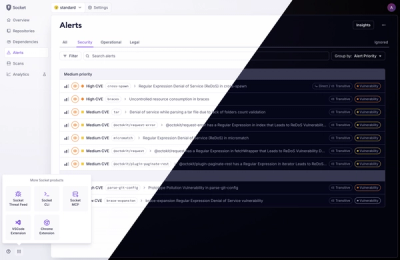
Product
A Fresh Look for the Socket Dashboard
We’ve redesigned the Socket dashboard with simpler navigation, less visual clutter, and a cleaner UI that highlights what really matters.
redis-semaphore
Advanced tools
Mutex and Semaphore implementations based on Redis ready for distributed systems
redisClient - required, configured redis clientkey - required, key for locking resource (final key in redis: mutex:<key>)timeouts optional
lockTimeout - ms, time after mutex will be auto released (expired)acquireTimeout - ms, max timeout for .acquire() callretryInterval - ms, time between acquire attempts if resource lockedrefreshInterval - ms, auto-refresh intervalconst Mutex = require('redis-semaphore').Mutex
const redis = require('redis')
const redisClient = redis.createClient()
async function doSomething() {
const mutex = new Mutex(redisClient, 'lockingResource')
await mutex.acquire()
// critical code
await mutex.release()
}
redisClient - required, configured redis clientkey - required, key for locking resource (final key in redis: semaphore:<key>)maxCount - required, maximum simultaneously resource usage counttimeouts optional
lockTimeout - ms, time after semaphore will be auto released (expired)acquireTimeout - ms, max timeout for .acquire() callretryInterval - ms, time between acquire attempts if resource lockedrefreshInterval - ms, auto-refresh intervalconst Semaphore = require('redis-semaphore').Semaphore
const redis = require('redis')
const redisClient = redis.createClient()
async function doSomething() {
const semaphore = new Semaphore(redisClient, 'lockingResource', 5)
await semaphore.acquire()
// maximum 5 simultaneously executions
await semaphore.release()
}
redisClient - required, configured redis clientkey - required, key for locking resource (final key in redis: semaphore:<key>)maxCount - required, maximum simultaneously resource usage counttimeouts optional
lockTimeout - ms, time after semaphore will be auto released (expired)acquireTimeout - ms, max timeout for .acquire() callretryInterval - ms, time between acquire attempts if resource lockedrefreshInterval - ms, auto-refresh intervalconst FairSemaphore = require('redis-semaphore').FairSemaphore
const redis = require('redis')
const redisClient = redis.createClient()
async function doSomething() {
const semaphore = new FairSemaphore(redisClient, 'lockingResource', 5)
await semaphore.acquire()
// maximum 5 simultaneously executions
await semaphore.release()
}
npm install --save redis-semaphore
# or
yarn add redis-semaphore
MIT
FAQs
Distributed mutex and semaphore based on Redis
The npm package redis-semaphore receives a total of 218,499 weekly downloads. As such, redis-semaphore popularity was classified as popular.
We found that redis-semaphore demonstrated a healthy version release cadence and project activity because the last version was released less than a year ago. It has 1 open source maintainer collaborating on the project.
Did you know?

Socket for GitHub automatically highlights issues in each pull request and monitors the health of all your open source dependencies. Discover the contents of your packages and block harmful activity before you install or update your dependencies.

Product
We’ve redesigned the Socket dashboard with simpler navigation, less visual clutter, and a cleaner UI that highlights what really matters.

Industry Insights
Terry O’Daniel, Head of Security at Amplitude, shares insights on building high-impact security teams, aligning with engineering, and why AI gives defenders a fighting chance.

Security News
MCP spec updated with structured tool output, stronger OAuth 2.1 security, resource indicators, and protocol cleanups for safer, more reliable AI workflows.